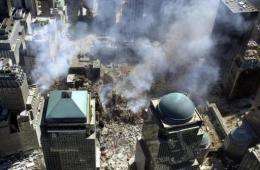Scientists still struggle to identify 9/11 remains

In a laboratory in the center of Manhattan scientists continue to struggle to put names to the remains of victims from the September 11, 2001 attacks, some 40 percent of which are still unidentified.
"It's not a legal obligation because everybody has a death certificate. It's an ethical-moral decision," said Mechthild Prinz in the department of forensic biology at the city's Chief Medical Examiner office.
The names of the people who died in the explosions, fires and collapse in the Twin Towers on 9/11 are known, but the violence was so extreme that even a decade later it takes painstaking forensic work to match those identities to the human fragments found at the site.
The latest match made was just this week: Ernest James, who was 40 years old. He was the 1,629th victim identified out of 2,753 people killed at the World Trade Center, or 59 percent of the total.
Initially, traditional methods such as dental records, photographs and finger prints were used to identify the bodies and remains pulled from the rubble. But as the easier batches of remains were dealt with the gruesome task turned into something more akin to serious detective work -- and even that is not enough in many cases.
"We did collect 21,817 remains, so you can imagine obviously that a lot of people were fragmented in many different body parts. And since we haven't identified over a thousand people, some of them really disappeared," said Prinz, 53, who comes from Germany but has been working as a forensic scientist in New York since 1995.
Amid strict security and sanitation conditions, a team of five scientists continues to deal with 6,314 fragments of bones found in the World Trade Center area.
An AFP journalist was shown the work underway through a window in a door before being told to put on gloves and taken into a large room, where robots clean the remains before they are tested for DNA against a databank created by relatives of the deceased.
"I remember a case a few years ago which was a small piece of bone on the roof of the Deutsche Bank building. It was the size of a coin and we were able to identified someone who worked in the towers at that time," recalled Taylor Dickerson, a criminalist in the forensic biology department.
However in most cases the DNA found in the fragments turns out to be just another piece of a person already identified. As a result, the work is painfully slow: less than three dozen people have been identified since 2006.
Sometimes, DNA is found in bone fragments that cannot be matched to anyone in the databank -- either because relatives did not give samples or because the remains belong to an illegal immigrant who happened to be in the area at the time and was never registered.
Prinz said the work, for all its frustrations, is satisfying.
"It definitely was worthwhile to do it, because some of the families are really grateful," he said.
"I guess the biggest thing for me has been just understanding the impact our work has on both the families and the community, the forensic community," Dickerson said. "I never expected to do that in my career."
(c) 2011 AFP
















